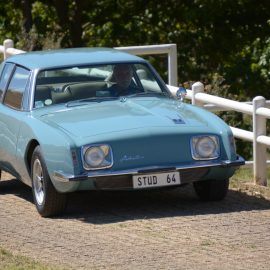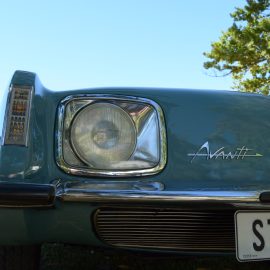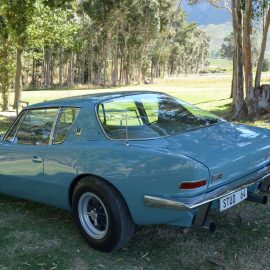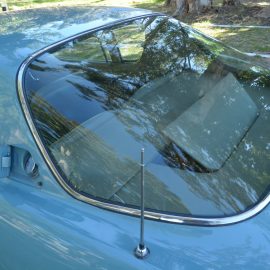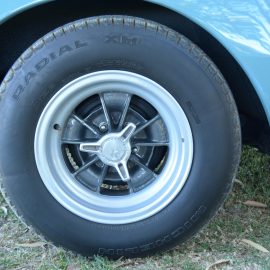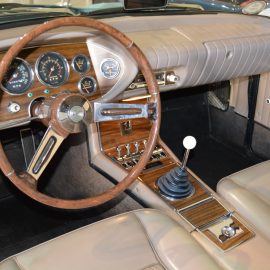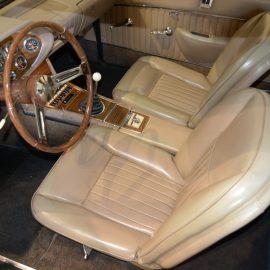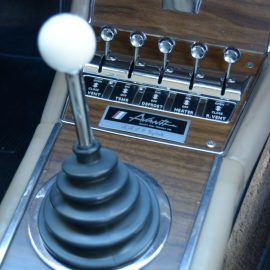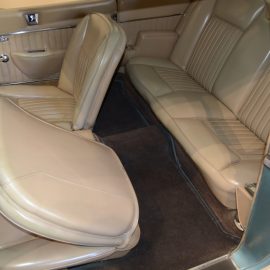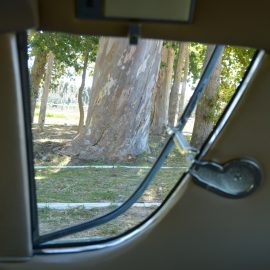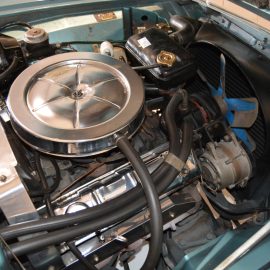
01 Aug Collection In Action: 1964 Studebaker Avanti
Raymond Loewy’s glass fibre-bodied, four-seater high-performance grand tourer was advertised as the inspiration for all ’63 Studebakers, but the concept was doomed from the start. Mike Monk drives one to see what might have been…
Studebaker had been in trouble since the early 1950s as a result of its high-paid labour force contributing towards its products being comparatively expensive to build when compared with those of Detroit’s Big Three, General Motors, Ford and Chrysler. A wages pay cut saved jobs and a merger with Packard kept the brand alive, but clearly all was not well – the company severed its links with influential design consultant Raymond Loewy (reportedly with a $1 million payout) and sales from the South Bend, Indiana plant continued to struggle.
Then in February 1961, 41-year-old Sherwood Harry Egbert took over as president with the aim of reviving Studebaker’s flagging fortunes by diversifying its interests. With no experience of the motor industry, he nevertheless decided to stimulate the business with a radical new car that he reportedly sketched out on a flight from Chicago just over a month after taking over. The incisive businessman rattled the company directors’ cage by calling in Loewy to oversee design of the ‘personal luxury coupé’. Loewy accepted the challenge, and after bringing together his experienced team of Bob Andrews, Tom Kellogg and John Ebstein, in just 40 days presented a clay mock-up.
Surprisingly perhaps, Studebaker’s directors approved the design that, apart from being the company’s first all-new body style since 1953, was quite dramatic, particularly at the front where thrusting, blade-like fenders flanked a grille-less nose. The long fender line gently swept back to the sloping rear with its large, wraparound back window – the stylised side windows behind the doors were quite small. Ornamentation was practically non-existent. Named Avanti – Italian for ‘forward’ – the decision was taken to base the car on the 109-inch (2 768 mm) wheelbase cross-braced steel chassis of the Lark Daytona convertible and produce the body in glass fibre.
Under the bonnet, Studebaker fitted a high-compression (10,25:1), 289ci (4735cc) V8 mated with either a three-speed manual gearbox with a floor shift or a Borg-Warner three-speed PowerShift automatic. The motor featured dual-point ignition, a sporty ¾-race high-lift cam, solid lifters, a four-barrel Carter carburettor and dual exhausts. In standard guise (R1) it delivered 240 bhp (179 kW) but a Paxton supercharged version (R2) was an option, with the compression ratio lowered to 9,0:1 and power raised to 290 bhp (216 kW). Later, just ten 335 bhp (253 kW) supercharged R3 versions were also built as well as a single naturally-aspirated R4 with dual four-barrel carbs that produced 280 bhp (209 kW). An experimental twin-supercharged, fuel-injected R5 developed a massive 575 hp (429 kW).
Suspension was by upper and lower A-arms with coil springs at the front, and a solid axle on semi-elliptic leaf springs at the rear. Bendix-Dunlop caliper disc brakes were fitted up front – a first for an American car – with conventional drums at the back.
Responsibility for body construction was placed in the hands of Molded Fibre Glass of Ashtabula, Ohio, who manufactured body parts for the glass fibre Chevrolet Corvette. But time, some cost cutting and inexperience with building complete bodies worked against the company, the absence of body jigs resulting in poor door and fender alignment on the early cars, and an ongoing ill-fitting rear window problem.
But despite the problems, the Avanti debuted at the New York International Motor Show in April 1962; just one year after Loewy’s clay proposal was given the green light. In May, a hand-built prototype Avanti was an honorary pace car at the Indianapolis 500. Race winner Rodger Ward received one as part of his prize package. Building on the performance theme, without the benefit of any wind tunnel testing, Loewy’s rakish design proved to be remarkably aerodynamic when a supercharged Avanti broke 29 speed records at the famous Bonneville Salt Flats, reaching a top speed of nearly 271 km/h, faster than any American production car had gone before.
Loewy’s team used Jaguar’s E-Type as one of its inspirational designs and the Avanti’s long nose is perhaps the most obvious similar design element. Its looks are certainly distinctive, particularly at the front, the overall styling looking more European GT (Kellogg’s influence, perhaps?) than American muscle, although performance was in the ball park of both classifications. This particular car is part of FMM’s collection and is one of the 1964 square-headlight R1s fitted with an optional four-speed all-synchromesh manual ’box: Body number is 4434.
The doors are bulky and open up to reveal an interior that is light and roomy, even in the rear where the small, tapered rear side glass is not as sideways visibility restricting as it suggests from the outside. A neat touch is a panel in the rear parcel shelf that opens up to give access to the boot. Pleated leather adorns the seats, door panels and facia with wood veneer used for the two-spoke steering wheel rim (with horn buttons in the spokes), the eight-dial instrument binnacle, the tunnel console and even the radio. Aircraft-style switchgear sprouts from the console and heating and lighting buttons are mounted in a panel in the windscreen header rail. The padded and quilted headliner is another neat touch and the overriding effect is of something a bit special – exciting, even futuristic.
Twist the key and the motor fires up with a healthy rumble. Snick the white ball-topped stubby gearshift into first and the Avanti pulls away with a surprising eagerness. Tipping the scales at around 1 430 kg, performance claims for the R1 were 0-60 mph (0-96 km/h) in 8,4 seconds, the quarter-mile in 16,3 seconds and a top speed of 130 mph (209 km/h). Torque is strong from low down – the healthy peak of 414 N.m is reached at 3 000 r/min – and the car really does have a Gran Turismo feel to it. The gearshift is a delight, having short throws with a well defined gate. Running on 215/75 R15 radials fitted to Halibrand alloys with fake spinners, the steering is naturally a little heavy when manoeuvring but improves as speed rises. Ride is comfortable and the car feels all of a piece. Brakes were up to the task and cruising along the Avanti is effortless, but the car’s dated chassis offers little finesse in the handling department.
Despite the Avanti’s promise and Studebaker’s “From the Advanced Thinking of the Studebaker Corporation” advertising, build quality problems continued and hampered sales from the onset, so by the end of 1963 only 3 834 units had been sold. Little was changed for the following year save for a switch from round to square headlights for the last 750 models before production ceased in December 1964 with a build total of just 4 643 cars. By this time Egbert was suffering with cancer and he died five years later. The Avanti concept was sold in 1965 to a couple of Studebaker dealers before passing through a number of other entrepreneurial hands, during which time small volumes of variations on the theme were manufactured over the next 20 years. “Avanti: The Maximum Automobile” was a gallant but ill-fated project that deserved greater reward.
FMM’s 1964 Studebaker Avanti is currently on view in Hall D.




